Right Message, Right Time
Why Well-Informed Outreach Makes All the Difference
Personalizing outreach has moved from just another item on the wish-list to a must-have for most marketers—and consumers are demanding more of it. In fact, 52% of consumers claim they actually consider switching brands if organizations don’t make an effort to personalize.
Consumers aren’t the only ones seeing the benefits. Organizations that use data to inform and personalize their outreach are building better relationships with those they wish to help. A recent survey revealed that 96% of participating marketers praised the ability of personalization to advance customer relationships—and 88% said they saw measurable results in their organization after running a personalized campaign.

These ideas hold true across all industries and services. Used correctly, personalization can be a powerful way for your organization to reach out, build relationships, increase engagement, and improve experience. The stats below show how retail stores benefit from personalization, but here at Gloo, we’re seeing these same types of results from organizations dedicated to personal growth and wellness.
When it comes to individuals who've had a personalized shopping experience:
-
44% are likely to become a repeat buyer
-
39% are likely to tell friends and family about their experience
-
32% are likely to leave a positive review
-
22% are likely to post something positive about it on social media
Andy Zimmerman, CMO of Evergage, has this to say, “Marketers are at a crossroads, and the path to success means leaving behind the status quo and taking steps to unleash the full benefits of personalization.”
We see personalization at work from the consumer’s end every day, and most of us have probably responded to it—for example, following through on a movie suggestion on Netflix, or clicking for more information on a product through an Amazon recommendation. These are just two organizations that use personalization, and they’re big orgs, so is their process even relevant to a business like yours?
Absolutely.
Did you know Netflix personalizes not only your movie suggestions based on what you've seen previously—they also personalize the movie art they show you to fit your specific tastes?
They’re so relevant that we’re going to look at the top three lessons you can learn from them to inform, and improve your outreach efforts—whether you’re creating a first-time campaign, or trying to keep people engaged after a big event.
1. Know your audience.
2. Make your offer relevant.
3. Reach your audience in the right place.
Know Your Audience
Forbes magazine recently published an article by Jayson DeMers that stated, “The better you know your audience, the more effectively you can create appealing content ideas, make formats decisions, handle positioning and placement, and promote the content.”
At Gloo, we feel it’s essential to add one more element to this list: connect with them. The better you know your audience, the more likely you are to connect with them so you can begin helping them on their personal growth journey.

Research has proven that healthy relationships can help us thrive in life as we pursue personal goals and seek opportunities for growth—but relationships can’t be formed unless you know your audience. Begin by taking inventory of the people you currently serve, so you can reach more who are like them.
You may want to identify:
-
The geographic area you're currently reaching
-
How far people are willing to travel to participate in your offer
-
The needs your people are striving to fulfill (e.g., financial, marriage, spiritual)
-
The growth opportunities they're seeking, or currently engaged in
-
The attributes of those who participated in your most recent events
-
The messaging that resonated with your people most recently
-
Their life-stages (e.g., millennials, newlyweds, grandparents, retirees)
-
Any stats or reports from recent campaigns
You can find a lot of information in your current CRM or other records your organization keeps. You can also find this data through specialized tools and resources, like we offer through Maps, Motivations, Reports, and Answers.
Once you have a comprehensive list of who your people are, you’ll notice some very similar traits and attributes. When you combine these into a persona, you’re able to inform your outreach as if you’re speaking to a single individual, simplifying the process of personalization in your offers and messaging.
If you’re not sure what to include in your persona, Gloo has a template available.
Make Your Offer Relevant
According to Forrester Consulting, 51% of mobile users feel the ads they see are irrelevant. This can lead consumers to feel the brands behind those ads are “annoying, irrelevant, repetitive, or interruptive.”
That doesn’t mean your offer needs to be changed or updated, but that you need to communicate your offer in the right language, with the right images, to the right people. For example, below you’ll see three different ads for bulbs and fixtures. The product is the same in each ad, but the audience is different, which means the way the offer is communicated has been altered so each audience feels it’s relevant to them.
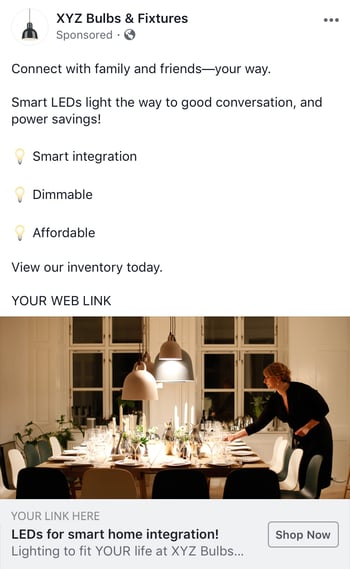
Audience: people who are curious about, and want to connect with various cultures, people, and experiences.
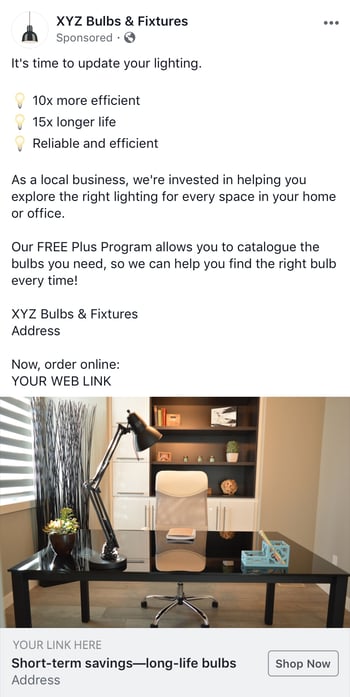
Audience: people who are secure in their finances and comfortable spending money.
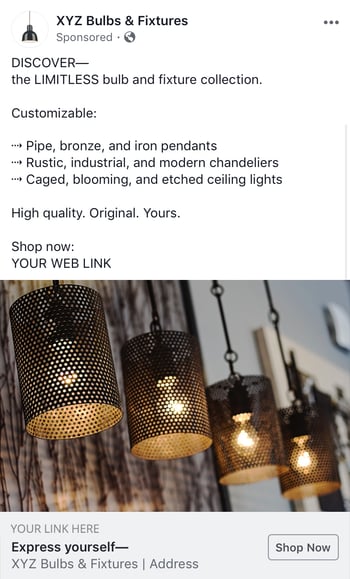
Audience: people who are hungry for spontaneity, want to express themselves, and want to push boundaries.
In this set of ads—based on actual client ads—each product and organization is different, but pay attention to how they approach their audiences.
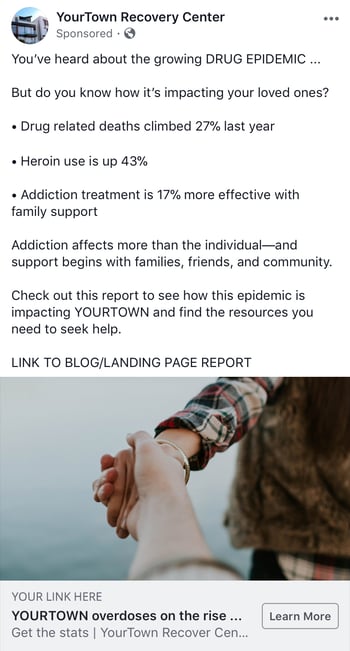
Audience: people with high family orientation who are likely to have a loved one with a substance use disorder.
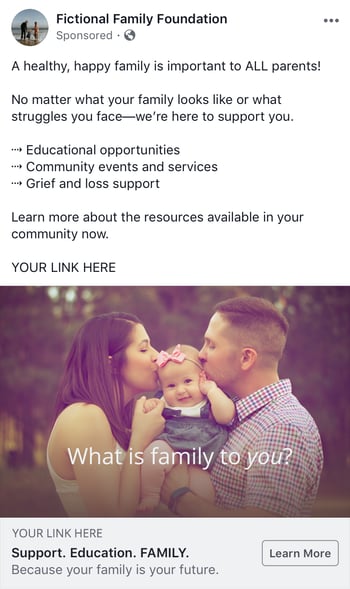
Audience: people with high family orientation, with traits what indicate some family or financial stress.
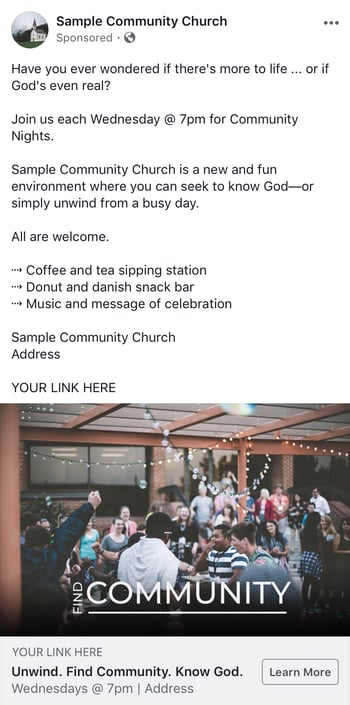
Audience: millennials who are seeking spirituality and opportunities to connect with diverse people or cultures.
To put this into play in your messaging, imagine you’re organizing a community service project to expand a local park. It’s open to all ages, and you need to get as many people involved as possible to meet your goal. You know your audience is family oriented, cares about their community, and likes to serve, but they can only make ends meet with two incomes, which means their time is limited. With this in mind, which message would be most likely to get a response?
-
Rebuild the City Park with a Donation of Just $50
-
Celebrate Community with Your Family—and an Hour of Service
-
Got an Hour? Make a Difference!
The second option appeals to their sense of family, and shows them how they can help, even with limited time available. Consider using an exercise like this as you come up with your own messaging.

To ensure your ads are relevant to your audience, check the following:
-
The pain point, or opportunity resonates with you audience
-
The copy uses the same terminology you audience uses
-
It’s written in a way that appeals to the right core motivations or values of your audience
-
The images reflect the right message or feelings
As you go through this list, make sure you pay attention to the data you gathered about your audience, and the persona you’ve developed.
Reach Your Audience in the Right Place
50% of people use Facebook daily—and list these three things among their top ten reasons for using social media:
-
Stay in touch with friends
-
Find entertaining content
-
Research new products to buy
Facebook has 2.3 billion monthly users today, with the average user spending more than 40 minutes of their daily life on the platform scrolling through content from their friends, reading news stories, and watching videos.
Facebook’s unparalleled targeting data, paired with its relative ease of use for marketers, has made it a critical channel of communication for brands of all shapes and sizes. So, as you begin to look for the right place to reach your audience, consider this: if your audience is human, it’s likely you can connect with them on Facebook.
Marketers are paying attention to these trends, and social media ad revenue is rising at a pace of 10.5% per year—exceeding $50 billion in 2018 alone. That makes social media—and Facebook in particular—a powerful place to reach and connect with the people you’re trying to serve. However, it may not be the most effective, at least for some audiences.
Millennials are probably the most well-connected (digitally) demographic, but they’re being overwhelmed by the time they spend in front of their monitors, cell phones, tablets, and TVs. Their brains are simply becoming saturated to the point that they suffer from digital fatigue.
That’s pushing direct mail into the hands of more consumers. You see, direct mail must be handled when it’s received, putting your offer, message, and image into your audience’s hands in a real and tangible way—even if they’re just throwing it in the trash. Email can be ignored and filtered, without your audience even knowing it’s been received. Digital ads can also be ignored, and scrolled past, becoming little more than a blur in the background. Direct mail, however, must be handled.
A study by Temple University discovered that people who receive print ads:
-
Spend more time reviewing the ads
-
Yield higher levels of recall
-
Exhibit more activity in brain areas associated with value and desire

Additional studies have yielded supporting stats. Check them out, specifically regarding millennials and print ads. The results may surprise you. They even surprised us!
-
92% of college students surveyed prefer reading in print over any form of digital media
-
90% of people ages 25–34 find direct mail reliable—and 87% like receiving it
-
82% of millennials believe messages on printed paper are more trustworthy than digital messages
Before you drop your social media ads in favor of print, however, consider this: campaigns that leverage both Facebook and direct mail increase conversions by 28%.

Next Steps
Once you know your audience, and the message that will resonate most with them, consider integrating both Facebook and direct mail into your campaign planning—to see how you can increase awareness and engagement.
Then make your outreach simple by using Gloo to know and define your audience, and activate on them through Facebook and our direct mail partners.
Already a Gloo customer? Talk with your Champion Success Manager to find out how you can leverage your time to achieve your goals.
New to Gloo? Check out our products to see how they can help inform your outreach strategy.
